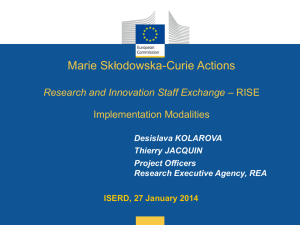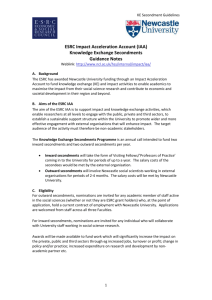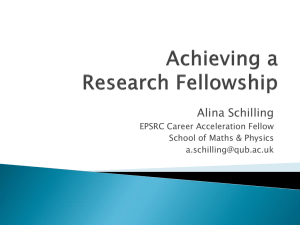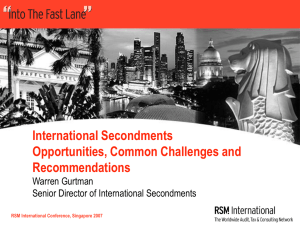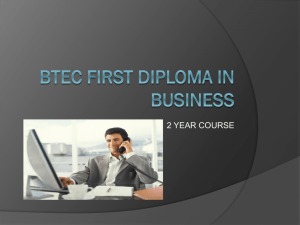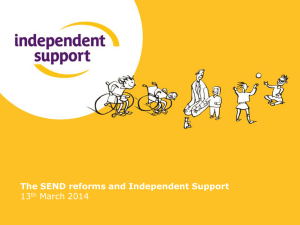RISE and IF Call 2014-2015
advertisement
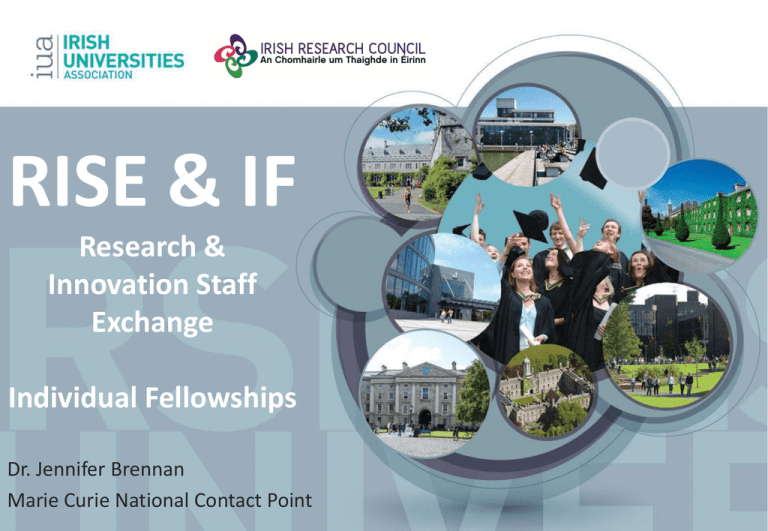
RISE & IF Research & Innovation Staff Exchange Individual Fellowships Dr. Jennifer Brennan Marie Curie National Contact Point ITN RISE COFUND NIGHT IF • Innovative Training Networks • Research & Innovation Staff Exchange • Co-financing fellowship or doctoral programmes with transnational mobility • European Researchers’ Night • Individual Fellowships Research & Innovation Staff Exchange Promoting international and inter-sectoral collaboration through research and innovation staff exchanges To foster a shared culture of research and innovation A Typical RISE • Consortium of organisations from different countries and sectors –including countries from outside Europe • Propose a joint research programme • Implemented by secondment of staff around the consortium (1 month to 12 months duration) • Networking/training events • “Staff” = research students, postdocs, PIs, technical and managerial staff Funding Model Categories of eligible costs Marie SkłodowskaCurie action RISE (100%) Costs of researchers (1) Institutional costs (2) Living allowance (a) Mobility allowance (b) Family allowance (c) Top-up allowance (d) -- -- -- 2 000 All values are PER MONTH Research, training and networking costs (a) 1 800 Management and indirect costs (b) 700 Two Sectors Academic <-> Non-Academic • Academic: consists of public or private higher education establishments awarding academic degrees, public or private non-profit research organisations whose primary mission is to pursue research, and international European interest organisations • Non-Academic: includes any socio-economic actor not included in the academic sector and fulfilling the requirements of the Horizon 2020 Rules for Participation. e.g. Industry (incl. SMEs), charities, NGOs, government/public bodies, national archives, libraries………… Two types of participant 1. Beneficiary: Organisations established in Member States or Associated Countries (in Europe) 2. Partner Organisations: Organisations established in countries outside Europe (not MS/AC). Non-European Countries “Other Third Countries” – two types 1. Participants listed in Annex A to the Work Programme (e.g. Egypt, Peru) can be a Partner Organisation with no restrictions. 2. Participants not listed in Annex A to the Work Programme (e.g. USA, Brazil) can be a Partner Organisation, but part of their participation must be funded from their own budget. Country 1 Academia Non-academia Country 2 Country 3 The Rules - Consortium • Minimum consortium size: 3 partners in 3 countries • Two Conditions: • 3 European partners: must be at least 1 non-academic partner and 1 academic partner • 2 European partners and one OTC partner: no intersectoral requirements • No max, but 6 to 10 is considered manageable Secondments – General Rules • Min. Duration 1 month, Max. 12 months (split stays possible) • “Staff” must be active at their host for 6 months before secondment • Must be reintegrated after secondment (no duration or mechanism specified) Secondments – European Only Consortium • All secondments must be international and intersectoral • E.g. from a HEI in Ireland to an SME in Germany • No secondments within the same country • No secondments within the same sector • E.g. from a HEI in Ireland to a HEI in Germany • E.g. from an SME in Germany to a MNC in France Example1 : European Only Consortium German NGO Polish University UK University Polish SME Secondments – International Consortium • Secondments within Europe must be international and inter-sectoral • • Secondments between Europe and “non-Europe” (OTC) can be inter or intra-sectoral • • • E.g. from a HEI in Ireland to a HEI in Chile No secondments within the same country No secondments between OTCs • • • E.g. from a HEI in Ireland to an SME in Germany E.g. from Chile to Pakistan “Annex A” OTCs – all secondments are financed by the project USA, Brazil etc. • • Secondments from Europe to OTC are financed by the project Secondments from OTC to Europe are financed by themselves Example 2: International Consortium German NGO Polish University UK University Chilean University Example 3: International Academic-Only Consortium German University US University UK University Chilean University Red Arrows: Eligible if USA funds it and is necessary for project Proposal Content 1. 2. 3. 4. 5. 6. 7. 8. Summary Excellence Overall page limit of 30 pages No section page limits Impact Implementation Gantt Chart Capacities of the Participating Organisations (tables) Ethical Aspects Letters of Commitment of Partner Organisations Success Rates • New Programmes, but incorporate elements of FP7 IAPP and IRSES • 2013 Success Rates • IRSES 38% • IAPP 16% RISE Calls 2014 and 2015 CALL Opening Date Closing Date H2020-MSCA-RISE-2014 11-Dec-2013 24-Apr-2014* H2020-MSCA-RISE-2015 6-Jan-2015 28-Apr-2015 2014 Call Budget €70 million 2015 Call Budget €80million * Results in November 2014 (indicative date) MSCA Individual Fellowships A personal fellowship to support a period of mobility Individual Fellowships • For Experienced Researchers • Post-PhD or equivalent • No upper age or experience limit • Fully-funded fellowships • Salary, research costs etc. • Minimum duration 1 year IF – European and Global Mobility rule European Cannot apply for a fellowship Fellowships in a country where you have lived for >12 months in the 3 1 – 2 years years before the Call deadline Global Fellowships 2 – 3 years Funding Model Categories of eligible costs Marie SkłodowskaCurie action IF (100%) Costs of researchers/seconded staff member Institutional costs PER MONTH PER MONTH Living allowance (a) Mobility allowance (b) Family allowance (c) Top-up allowance (d) 4 650 600 500 -- Research, training and networking costs (a) 800 Management and indirect costs (b) 650 Examples from FP7 Dr. Elena Martines, UCD • Early-career researcher who studied/worked in Scotland, France, Sweden, Spain and Italy • Moved to UCD in 2009, then successfully applied for a Marie Curie Fellowship in 2010 Prof. Gary Stutte, LIT • NASA Researcher since 1992 who began a collaboration with LIT in 2002 • Moved to LIT on Marie Curie Fellowship awarded in 2010 Dr. Gillian Hendy, NUIM and Massachusetts Institute of Technology • Recent PhD graduate from NUIM working in Analog Devices after graduation • Awarded a Marie Curie Fellowship in 2010 to spend two years at MIT working with Prof. Robert Langer • Just returned to NUIM to complete the reintegration year of the Fellowship Success Rates • New Programmes, but based on FP7 • 2013 Success Rates • Intra-European Fellowship 14% • International Incoming Fellowship 9.5% • International Outgoing Fellowship 12.5% ~ European Fellowships Global Fellowships IF Calls 2014 and 2015 CALL Opening Date Closing Date H2020-MSCA-IF-2014 12-Mar-2014 11-Sep-2014 H2020-MSCA-IF-2015 12-Mar-2015 10-Sep-2015 2014 Call Budget €240.5 million 2015 Call Budget €213 million • M€211.5 for European Fellowships • M€186 for European Fellowships • M€29 for Global Fellowships • M€27 for Global Fellowships Thank you! mariecurie@iua.ie www.iua.ie/mariecurie Marie Curie Office Ireland Deadlines 2014 CALL Opening Date Closing Date H2020-MSCA-NIGHT-2014 11-Dec-2013 4-Mar-2014 H2020-MSCA-ITN-2014 11-Dec-2013 9-Apr-2014 H2020-MSCA-RISE-2014 11-Dec-2013 24-Apr-2014 H2020-MSCA-IF-2014 12-Mar-2014 11-Sep-2014 H2020-MSCA-COFUND-2014 10-Apr-2014 2-Oct-2014 Download the Work Programme and Call Documentation at http://ec.europa.eu/research/participants/portal/desktop/en/opportunities/h2020/index.html Work Programme covers Calls in 2014 and 2015 Tips and Tricks! Excellence (50%) Impact (30%) Implementation (20%) Quality, innovative aspects and credibility of the research (including inter/multidisciplinary aspects) Enhancing research- and innovationrelated human resources, skills and working conditions to realise the potential of individuals and to provide new career perspectives Overall coherence and effectiveness of the work plan, including appropriateness of the allocation of tasks and resources Clarity and quality of knowledge sharing among the participants in light of the research and innovation objectives. To develop new and lasting research collaborations, to achieve transfer of knowledge between research institutions and to improve research and innovation potential at the European and global levels Appropriateness of the management structures and procedures, including quality management and risk management Quality of the interaction between the participating organisations Effectiveness of the proposed measures for communication and results dissemination Appropriateness of the institutional environment (infrastructure) Competences, experience and complementarity of the participating organisations and institutional commitment General Comments - 1 • Use a self-explanatory title • A memorable acronym is helpful • Use the proposal template: • It matches the evaluation criteria and makes it easy for the evaluators to find what they are looking for. • It helps you to put the right information in the right place for the evaluators to find it. • Some evaluators use a “checklist” approach to marking – if the information is not in the correct section, they will give you “zero” for that sub-criterion. General Comments - 2 • Use Diagrams, Charts, Tables or Figures where possible • Easy to evaluate • Minimise scientific jargon and write in a clear readable style • Be aware of the overall weighting of each criterion • You need to score well in all sections in order to be funded – don’t spend all your time writing the Excellence section! Abstract (Admin forms) & Summary (Part B) Provided to evaluators to help them choose the proposals they will evaluate • Be concise • Reflect the whole proposal including proposed impact • Identify precise & concrete objectives for the whole proposal, not just the research • Provide enough technical/research information to help an evaluator with knowledge of the field to select it Layout of Proposal Not evaluated but it makes life easier for the evaluators Template Format Language • Use the Correct Template • Use the Template subheadings (provides good structure) • Provide a Table of Contents with page numbers • Use the Full Page Limits • Put the proposal acronym in the Header • Put Page Numbers (format Page X of Y) in the Footer • Use charts, diagrams, tables, text boxes, figures. • Use appropriate font size, line spacing, page margins • Ensure any colour diagrams etc. are understandable when printed in black and white • Use highlighting where appropriate (bold, underline, italics) but don’t overdo it! • Avoid jargon • Explain any abbreviations • Simple clear text • Avoid long sentences • Get rid of repetitions (refer to other parts of proposal if necessary) • Don’t copy text from other documents or websites • Be consistent with language (UK/US English) 2.1 Quality of research programme • Educate the Evaluator • The majority of evaluators will not be expert in the specific subject area of the proposal so…. • Write in a style that is accessible to the non-expert using figures/tables/charts/diagrams to illustrate where appropriate • Research objectives • Make them clear, focused and up front • Relate them to the state-of-the-art and Make sure the ‘state of the art’ is up to date • Include a list of bibliographic references (in Section 5) 2.1 Quality of research programme • “Scope of the call”; Why do you need to work together on this research? How will the project “foster a shared culture of research and innovation”? • Provide a clear, focused description of the research methodology (use diagrams to explain/illustrate your point) • Include a description of any risks associated with the research and contingency plans in case any of those risks occur • Highlight originality and innovative aspects of the proposal • Use a list, table, text box etc. to make them stand out • Clearly specify any inter- and multi-disciplinary aspects 2.2 Quality of Knowledge-Sharing • Spell out the knowledge-sharing objectives w.r.t. the research objectives • Detail the Secondments which will take place • How will the secondments contribute to the knowledge-sharing objectives? • How will secondees transfer knowledge whilst on secondment, and how will they embed that knowledge into their home organisation (if desirable) when they return • If there are any novel aspects (social media, cloud-based data sharing etc.), highlight them • “A picture tells a thousand words” 2.3 Quality of interaction • Clearly state what each partner will contribute towards achieving the research objectives • Include their contribution to networking events, and their participation in the secondments • Describe the networking events which will take place • How will the events contribute to the knowledgesharing objectives? 3.1: Research HR and new career perspectives In all sections, be specific: provide details of how the impact will be achieved. • Explain the impact of the research and training on the Staff’s careers, e.g. • Research skills, transferable skills gained • Exposure to non-academic sector, organisations outside Europe • Look to EU policies on research which refer to training/careers for researchers • • • • E.g. Innovation Union, Agenda for New Skills and Jobs, Youth on the Move Principles for Innovative Doctoral Training and it’s Implementation Report Final Report of the Expert Group on the Research Profession Most docs are available on the EURAXESS Policy Library http://ec.europa.eu/euraxess/index.cfm/services/researchPolicies • Don’t simply cut and paste from EU docs or “pay lip service” by naming them in the document – present an analysis of how the ITN fits in with their objectives 3.2: Developing collaborations and improving EU Innovation Capacity • What are your plans for building the collaboration and continuing it after the RISE project has ended? • Relate to EU policies on international and inter-sectoral collaboration in Research & Innovation International Cooperation http://ec.europa.eu/research/iscp/index.cfm, Innovation Union • Innovation capacity – refer to the impact of the research – can link to Innovation Union objectives, research roadmaps, European Standardisation,…. 3.3: Communication and Dissemination What is the Impact of these activities? • Dissemination & Exploitation • Ensure you target multiple audiences, e.g. other researchers, policy makers (can link to European excellence), industry, government science advisors, “think tanks”, legislative bodies….. • Outline plans to exploit any IP arising from the programme • Public Engagement • Do not underestimate its importance – see Guidelines doc at http://ec.europa.eu/research/mariecurieactions/documents/docume ntation/publications/guidelines_en.pdf for details. • Include specifics (what – who – when) in a readable format (e.g. table) • Target different groups (students at all education levels and the general public) – participation in a European Researchers’ Night 4.1: Workplan • Must have a clear work plan • Use the standard tables provided, which use the standard EU format of Work Packages, deliverables and milestones – be clear and concise • Provide a Gantt Chart to illustrate timelines. Templates available at http://www.hyperion.ie/templates.htm • Don’t just have research Work Packages, include, e.g.: • Management • Dissemination, Exploitation and Public Engagement 4.2: Management Structure & Procedures • Must have a clear management plan, to explain who will do what and when. Tasks include: • • • • Financial management Monitoring progress Management of risk in the consortium Gender aspects – decision making, and participation in the secondments and networking events • IPR • …. • Describe which institutional departments will help with managing the programme (Finance, HR etc.) and what their experience is • You can use a PERT chart to illustrate who will be responsible for what templates available at http://www.hyperion.ie/templates.htm 4.3: Infrastructure, HR and Expertise • Who is doing what, and do they have the necessary infrastructure to do it? • Infrastructures: technical and other such as access to library and IT facilities etc. • Demonstrate that the participants have the necessary “Staff” to carry out the programme (secondments in particular). • Have the organisations endorsed the Charter & Code – if yes, say so! • List at http://ec.europa.eu/euraxess/index.cfm/rights/charterAndCode • Are the organisations towards earning the “HR Excellence in Research” logo? If yes, say so! List at http://ec.europa.eu/euraxess/index.cfm/rights/strategy4ResearcherOrgs But….don’t assume that evaluator knows what this means. Explain it to them. 4.3: Competences and Complementarity • Clearly explain the complementarities between the partners and how these will be exploited (use a diagram or table) • If you have a Beneficiary from a country who cannot automatically get funding from Horizon 2020, need to underline that • Any secondments from that country to Europe will come from the Beneficiary’s own budget • These secondments are essential to achieve the knowledge-transfer objectives. Q. Would it work if the secondment were in the opposite direction? • Institutional Commitment – a commitment to reintegrate the researchers after secondment is required. 7: Ethics Issues • All proposals will be checked for ethics issues • Ethics Table is in the Administrative Forms • If you indicate Ethics Issues in the Table: • Clearly describe how Ethical Issues will be managed • How does the proposal meet national legal and ethical requirements of the host country? • Who will oversee the project’s ethical aspects? E.g. institutional ethics committee, Data Protection Officer • Provide sample consent forms etc. • There is no page limit, so provide as much relevant information as possible 8. Letters of Commitment For Partner Organisations only • Content is important • Generic letters are not useful • Must contain specifics about role and participation of Partner Organisations and their commitment to do so (“own budget” issue again) Gender • Gender Quality and Gendered Innovations are mainstreamed throughout Horizon 2020 • Gender experts on every Evaluation Panel • In your proposal, describe • Gender equality in decision making, secondments, network events • Any gender aspects in relation to the research e.g. cardiovascular research, crash-test dummies
